Brother BAS-300G-484, BAS-342E, BAS-300G-484SF Owner's Manual
KE-430D
ELECTRONIC DIRECT DRIVE LOCKSTITCH
BAR TACKER
BE-438D
ELECTRONIC DIRECT DRIVE LOCKSTITCH
BUTTON SEWER
KE-430D, BE-438D

Thank you very much for buying a BROTHER sewing machine. Before using your new machine, please read the safety instructions below and the explanations given in the instruction manual.
With industrial sewing machines, it is normal to carry out work while positioned directly in front of moving parts such as the needle and thread take-up lever, and consequently there is always a danger of injury that can be caused by these parts. Follow the instructions from training personnel and instructors regarding safe and correct operation before operating the machine so that you will know how to use it correctly.
SAFETY INSTRUCTIONS
1. Safety indications and their meanings
This instruction manual and the indications and symbols that are used on the machine itself are provided in order to ensure safe operation of this machine and to prevent accidents and injury to yourself or other people.
The meanings of these indications and symbols are given below.
Indications
DANGER The instructions which follow this term indicate situations where failure to follow the instructions will result in death or serious injury.
The instructions which follow this term indicate situations where failure to follow the CAUTION instructions could cause injury when using the machine or physical damage to equipment
and surroundings.
Symbols



This symbol (  ) indicates something that you should be careful of. The picture inside the triangle indicates the nature of the caution that must be taken.
) indicates something that you should be careful of. The picture inside the triangle indicates the nature of the caution that must be taken.
(For example, the symbol at left means “beware of injury”.)
This symbol (  ) indicates something that you must not do.
) indicates something that you must not do.
This symbol (  ) indicates something that you must do. The picture inside the circle indicates the nature of the thing that must be done.
) indicates something that you must do. The picture inside the circle indicates the nature of the thing that must be done.
(For example, the symbol at left means “you must make the ground connection”.)
KE-430D, BE-438D |
i |
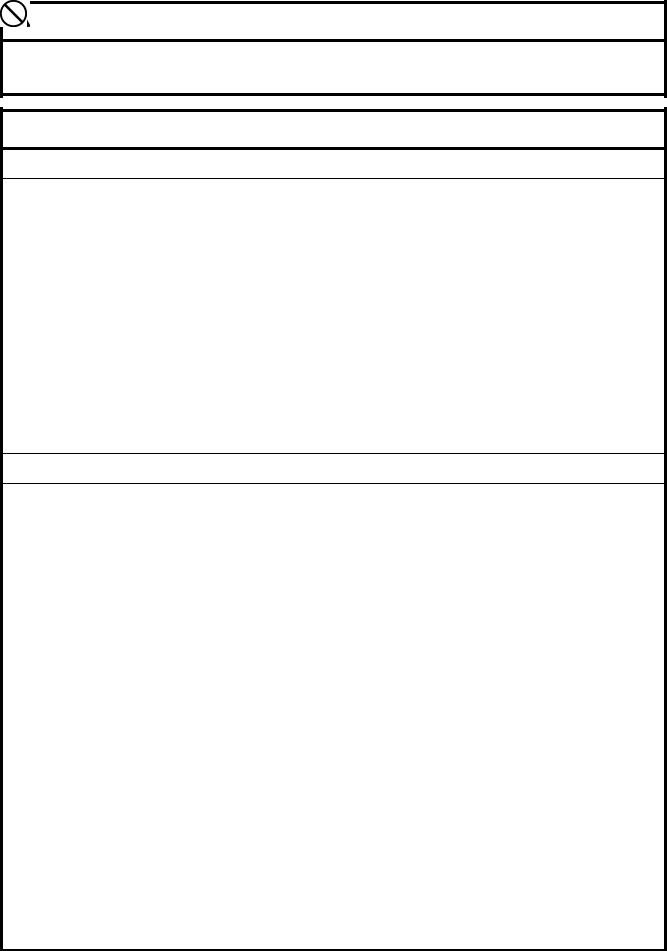
2. Notes on safety
 DANGER
DANGER
Wait at least 5 minutes after turning off the power switch and disconnecting the power cord from the wall outlet before opening the face plate of the control box. Touching areas where high voltages are present can result in severe injury.
 CAUTION
CAUTION
Environmental requirements
Use the sewing machine in an area which is free from sources of strong electrical noise such as electrical line noise or static electric noise.
Sources of strong electrical noise may cause problems with correct operation.
Any fluctuations in the power supply voltage should be within ±10% of the rated voltage for the machine. Voltage fluctuations which are greater than this may cause problems with correct operation.
The power supply capacity should be greater than the requirements for the sewing machine’s power consumption.
Insufficient power supply capacity may cause problems with correct operation.
The ambient temperature should be within the range of 5°C to 35°C during use.
Temperatures which are lower or higher than this may cause problems with correct operation.
The relative humidity should be within the range of 45% to 85% during use, and no dew formation should occur in any devices.
Excessively dry or humid environments and dew formation may cause problems with correct operation.
In the event of an electrical storm, turn off the power and disconnect the power cord from the wall outlet. Lightning may cause problems with correct operation.
Installation
Machine installation should only be carried out by a qualified technician.
Contact your Brother dealer or a qualified electrician for any electrical work that may need to be done.
The sewing machine weighs approximately 56 kg. The installation should be carried out by two or more people.
Do not connect the power cord until installation is complete, otherwise the machine may operate if the foot switch is depressed by mistake, which could result in injury.
Hold the machine head with both hands when tilting it back or returning it to its original position. Furthermore, after tilting back the machine head, do not push the face plate side or the pulley side from above, as this could cause the machine head to topple over, which may result in personal injury or damage to the machine.
Be sure to connect the ground. If the ground connection is not secure, you run a high risk of receiving a serious electric shock, and problems with correct operation may also occur.
All cords should be secured at least 25 mm away from any moving parts. Furthermore, do not excessively bend the cords or secure them too firmly with staples, otherwise there is the danger that fire or electric shocks could occur.
Install the safety covers to the machine head and motor.
If using a work table which has casters, the casters should be secured in such a way so that they cannot move.
Be sure to wear protective goggles and gloves when handling the lubricating oil and grease, so that they do not get into your eyes or onto your skin, otherwise inflammation can result.
Furthermore, do not drink the oil or eat the grease under any circumstances, as they can cause vomiting and diarrhoea.
Keep the oil out of the reach of children.
ii |
KE-430D, BE-438D |

|
|
|
CAUTION |
|
|||
|
|
|
|
|
|
||
|
|
|
Sewing |
|
|
||
This sewing machine should only be used by |
If using a work table which has casters, the casters |
||||||
operators who have received the necessary training |
should be secured in such a way so that they cannot |
||||||
in safe use beforehand. |
|
|
move. |
|
|||
The sewing machine should not be used for any |
Attach all safety devices before using the sewing |
||||||
applications other than sewing. |
|
|
machine. If the machine is used without these |
||||
Be sure to wear protective goggles when using the |
devices attached, injury may result. |
|
|||||
Do not touch any of the moving parts or press any |
|||||||
machine. |
|
|
|
||||
If goggles are not worn, there is the danger that if a |
objects against the machine while sewing, as this |
||||||
needle breaks, parts of the broken needle may enter |
may result in personal injury or damage to the |
||||||
your eyes and injury may result. |
|
|
machine. |
|
|||
Turn off the power switch at the following times, |
If an error occurs in machine operation, or if abnormal |
||||||
otherwise the machine may operate if the foot switch |
noises or smells are noticed, immediately turn off the |
||||||
is depressed by mistake, which could result in injury. |
power switch. Then contact your nearest Brother |
||||||
• When threading the needle |
|
|
dealer or a qualified technician. |
|
|||
• When replacing the needle and bobbin |
|
If the machine develops a problem, contact your |
|||||
• When not using the machine and when leaving the |
nearest Brother dealer or a qualified technician. |
|
|||||
machine unattended |
|
|
|
|
|||
|
|
|
|
|
|||
|
|
|
Cleaning |
|
|||
Turn off the power switch before carrying out |
Be sure to wear protective goggles and gloves when |
||||||
cleaning, otherwise the machine may operate if the |
handling the lubricating oil and grease, so that they |
||||||
foot switch is depressed by mistake, which could |
do not get into your eyes or onto your skin, otherwise |
||||||
result in injury. |
|
|
|
inflammation can result. |
|
||
|
|
|
|
|
Furthermore, do not drink the oil or eat the grease |
||
|
|
|
|
|
under any circumstances, as they can cause vomiting |
||
|
|
|
|
|
and diarrhoea. |
|
|
|
|
|
|
|
Keep the oil out of the reach of children. |
|
|
|
|
|
|
||||
|
|
Maintenance and inspection |
|
||||
Maintenance and inspection of the sewing machine |
Hold the machine head with both hands when tilting it |
||||||
should only be carried out by a qualified technician. |
back or returning it to its original position. |
|
|||||
Ask your Brother dealer or a qualified electrician to |
Furthermore, after tilting back the machine head, do |
||||||
not push the face plate side or the pulley side from |
|||||||
carry out any maintenance and inspection of |
the |
||||||
above, as this could cause the machine head |
to |
||||||
electrical system. |
|
|
|
||||
|
|
|
topple over, which may result in personal injury or |
||||
Turn off the power switch and disconnect the power |
|||||||
damage to the machine. |
|
||||||
cord from the wall outlet at the |
following times, |
Use only the proper replacement parts as specified |
|||||
otherwise the machine may operate if the foot switch |
|||||||
by Brother. |
|
||||||
is depressed by mistake, which could result in injury. |
|
||||||
If any safety devices have been removed, be |
|||||||
• When |
carrying |
out inspection, |
adjustment |
and |
|||
maintenance |
|
|
|
absolutely sure to re-install them to their original |
|||
• When |
replacing |
consumable parts such as |
the |
positions and check that they operate correctly before |
|||
using the machine. |
|
||||||
rotary hook |
|
|
|
|
|||
|
|
|
Any problems in machine operation which result from |
||||
If the power switch needs to be left on when carrying |
|||||||
unauthorized modifications to the machine will not be |
|||||||
out some adjustment, be extremely careful to observe |
|||||||
covered by the warranty. |
|
||||||
all safety precautions. |
|
|
|
||||
|
|
|
|
||||
|
|
|
|
|
|||
|
|
|
KE-430D, BE-438D |
iii |
|||
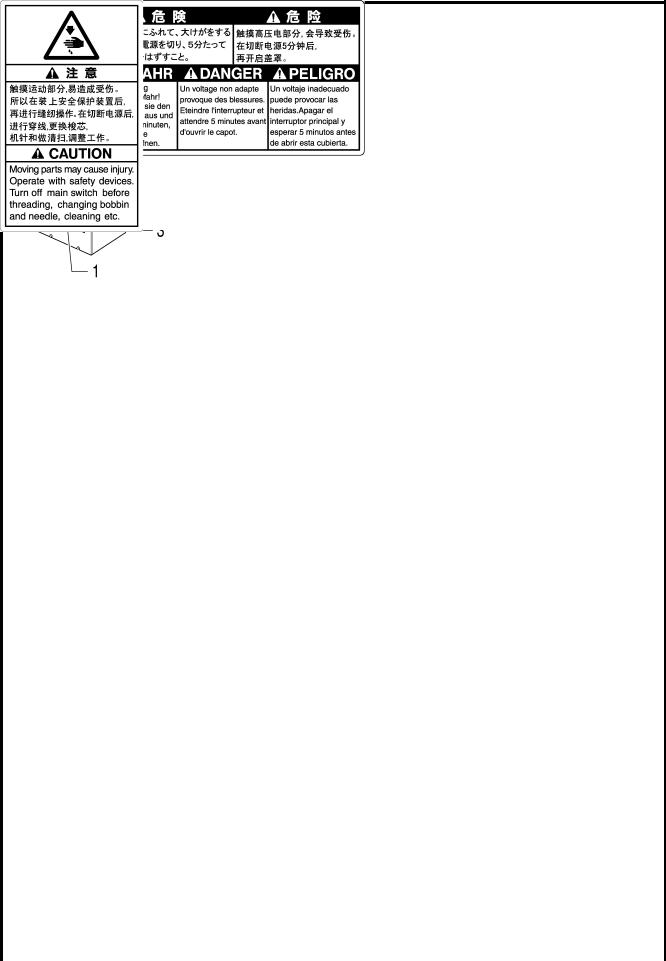
3. Warning labels
The following warning labels appear on the sewing machine.
Please follow the instructions on the labels at all times when using the machine. If the labels have been removed or are difficult to read, please contact your nearest Brother dealer.
1
3
4
2
Be sure to connect the ground. If the ground connection is not secure, you run a high risk of receiving a serious electric shock, and problems with correct operation may also occur.
|
Safety devices |
Direction of operation |
Eye guard |
|
Finger guard |
|
Tension release solenoid cover |
|
Thread take-up cover |
|
Frame side cover |
|
Back cover, etc. |
Thread take-up cover
Eye guard
Finger guard |
Tension release |
|
solenoid cover |
|
Back cover |
|
Frame side cover |
4399Q |
4467Q |
|
|
iv |
KE-430D, BE-438D |
CONTENTS
1. NAMES OF MAJOR PARTS ................ |
1 |
2. SPECIFICATIONS ................................ |
2 |
2-1. Machine specifications ................................... |
2 |
2-2. Program list (KE-430D) .................................. |
3 |
2-3. Program list (BE-438D) .................................. |
8 |
3. INSTALLATION.................................... |
11 |
3-1. Table processing diagram .............................. |
11 |
3-2. Installing the control box................................. |
12 |
3-3. Installing the oil pan........................................ |
12 |
3-4. Installing the machine head............................ |
13 |
3-5. Installing the operation panel ......................... |
14 |
3-6. Installing the treadle unit ................................ |
14 |
3-7. Installing the cotton stand............................... |
15 |
3-8. Installing the button tray (BE-438D) ............... |
15 |
3-9. Installing the eye guard .................................. |
15 |
3-10. Connecting the cords ................................... |
16 |
3-11. Connecting the ground wire ......................... |
18 |
3-12. Installing the back cover............................... |
19 |
3-13. Lubrication .................................................... |
20 |
3-14. Connecting the power cord .......................... |
21 |
3-15. Starting up .................................................... |
22 |
5. USING THE OPERATION PANEL |
|
(BASIC OPERATIONS)........................ |
31 |
5-1. Name and function of each |
|
operation panel item ....................................... |
31 |
5-2. Setting the program number ........................... |
33 |
5-3. Setting the X-scale and Y-scale...................... |
33 |
5-4. Setting the sewing speed................................ |
33 |
5-5. Checking the sewing pattern (KE-430D) ........ |
34 |
5-6. Checking the sewing pattern (BE-438D) ........ |
35 |
5-7. Adjusting the work clamp / button clamp |
|
lift amount........................................................ |
36 |
6. USING THE OPERATION PANEL |
|
(ADVANCED OEPRATIONS)............... |
37 |
6-1. List of advanced functions .............................. |
37 |
6-2. Setting memory switches................................ |
38 |
6-3. List of memory switches ................................. |
39 |
6-4. Using the lower thread counter....................... |
40 |
6-5. Using the production counter.......................... |
41 |
6-6. Using user programs ...................................... |
42 |
6-7. Using cycle programs ..................................... |
45 |
6-8. Direct selection ............................................... |
48 |
6-9. Loading additional sewing data ...................... |
48 |
4. PREPARATION BEFORE SEWING..... |
23 |
|
4-1. Installing the needle........................................... |
23 |
|
4-2. Threading the upper thread............................ |
23 |
|
4-3. Winding the lower thread................................ |
25 |
|
4-4. Installing the bobbin case............................... |
26 |
|
4-5. Thread tension................................................ |
26 |
|
|
4-5-1. Lower thread tension .......................... |
26 |
|
4-5-2. Upper thread tension .......................... |
27 |
4-6. |
Thread nipper device...................................... |
28 |
4-7. |
Inserting the button (BE-438D)....................... |
30 |
4-8. |
Adjusting the button clamp (BE-438D)........... |
30 |
4-9. |
Installing the accessory spring (BE-438D) ..... |
30 |
7. SEWING ............................................... |
49 |
|
8. MAINTENANCE.................................... |
50 |
|
8-1. Cleaning the rotary hook................................. |
50 |
|
8-2. Cleaning the control box air inlet ports ........... |
51 |
|
8-3. Draining the oil ................................................ |
51 |
|
8-4. Cleaning the eye guard................................... |
51 |
|
8-5. |
Checking the needle ....................................... |
51 |
8-6. |
Lubrication ...................................................... |
51 |
8-7. |
Applying grease |
|
|
(Work clamp: KE-430D).................................. |
52 |
8-8. |
Applying grease |
|
|
(When “GREASEUP” appears)....................... |
52 |
9. TABLE OF ERROR CODES................. |
55 |
KE-430D, BE-438D
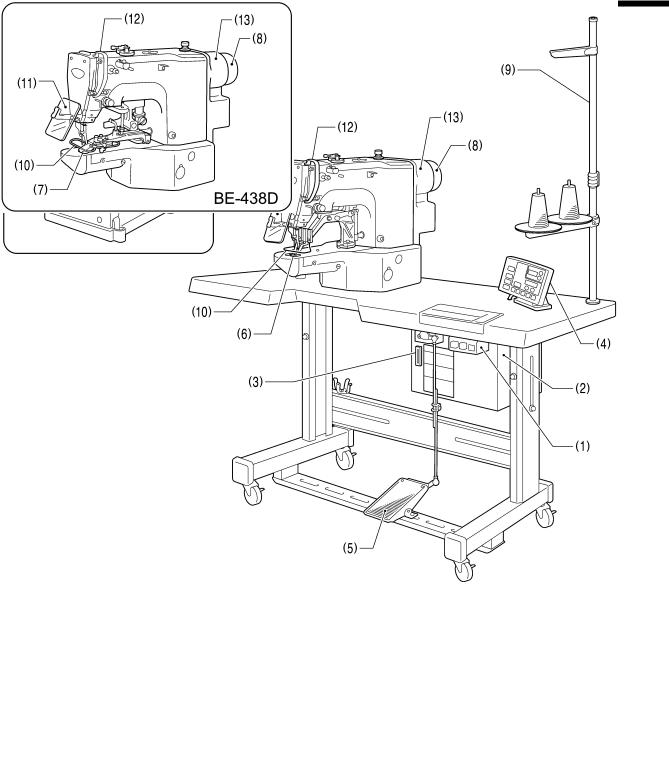
1. NAMES OF MAJOR PARTS
1. NAMES OF MAJOR PARTS
|
|
|
|
|
4400Q |
|
|
|
|
||
4401Q |
|
|
|||
(1) |
Power switch |
Safety devices |
|||
(2) |
Control box |
(10) |
Finger guard |
||
(3) |
CF slot |
(11) Eye guard |
|||
(4) |
Operation panel |
(12) Thread take-up cover |
|||
(5) |
Foot switch |
(13) |
Back cover |
||
(6) |
Work clamp (KE-430D) |
(14) |
Frame side cover |
||
(7) |
Button clamp (BE-438D) |
(15) Tension release solenoid cover |
|||
(8)Pulley
(9)Cotton stand
CFTM is a trademark of SanDisk Corporation.
1 |
KE-430D, BE-438D |
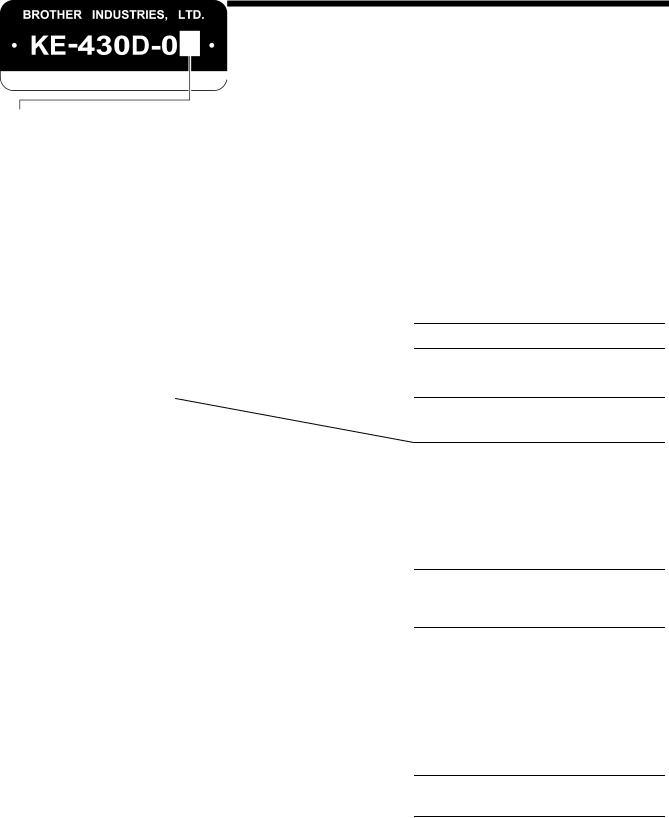
2. SPECIFICATIONS
2. SPECIFICATIONS
2-1. Machine specifications
|
1 |
Ordinary materials |
|
|
|
|
|
2 |
Denim |
|
|
|
|
|
7 |
Knitted materials |
|
|
|
|
|
F |
Foundation garments |
|
|
|
|
|
|
|
|
|
|
|
|
|
|
|
KE-430D |
BE-438D |
|
|
|
|
Electronic direct drive lockstitch bar tacker |
Electronic direct drive lockstitch button sewer |
||
|
|
|
|
|
||
Stitch formation |
|
Single needle lock stitch |
|
|||
|
|
|
|
|
||
Maximum sewing speed |
|
3,200 rpm |
2,700 rpm |
|
||
|
|
|
|
|
||
Pattern size (X x Y) |
|
40 x 30 mm max. |
6.4 x 6.4 mm max. |
|
||
|
|
|
|
|
||
Dimensions of buttons |
|
|
Outer diameter of button 8 - 30 mm (*1) |
|||
that can be sewn |
|
|
||||
|
|
|
|
|||
|
|
|
|
|||
Feed mechanism |
|
Y-θ intermittent feed mechanism (pulse-motor driven mechanism) |
||||
|
|
|
|
|||
Stitch length |
|
0.05 - 12.7 mm |
|
|||
|
|
|
|
|
||
Number of stitches |
|
Variable (Refer to "Program List" for details on the number of stitches |
||||
|
for sewing patterns that are already preset.) |
|
||||
|
|
|
|
|
||
Maximum stitch number |
|
210,000 stitches (including 200,000 stitches which can be added) |
||||
|
|
|
|
|||
Work clamp lifter |
|
Pulse-motor driven mechanism |
|
|||
|
|
|
|
|
||
Work clamp height |
|
17 mm max. |
13 mm max. |
|
||
Button clamp height |
|
|
||||
|
|
|
|
|||
Rotary hook |
|
Shuttle hook (shuttle hook 2, optional) |
Shuttle hook |
|
||
|
|
|
|
|
||
Wiper device |
|
Standard equipment |
|
|||
|
|
|
|
|||
Thread trimmer device |
|
Standard equipment |
|
|||
|
|
|
|
|||
Thread nipper device |
|
Standard equipment |
|
|||
|
|
|
||||
Data storage method |
|
Flash memory (Any sewing pattern can be added using CF card) (*2) |
||||
|
|
|
|
|
||
Number of user programs |
|
|
50 |
|
||
|
|
|
|
|
||
Number of cycle programs |
|
|
9 |
|
||
|
|
|
|
|
|
|
|
|
|
|
89 sewing patterns |
53 sewing patterns |
|
Number of stored data |
|
are set already |
are set already |
|
||
|
|
|
|
|||
|
|
|
|
(Up to 200 patterns can be added. Total number of stitches of stored data |
||
|
|
|
|
which can be added is within 200,000.) |
|
|
Motor |
|
|
AC servo motor 550 W |
|
||
|
|
|
|
|
|
|
Weights |
|
Machine head: approx. 56 kg, Operation panel: approx. 0.6 kg |
|
|||
|
Control box: 14.2 – 16.2 kg (depending on destination) |
|
||||
|
|
|
|
|
||
|
|
|
|
|||
Power source |
|
Single-phase 100V / 220V, 3-phase 200V / 220V / 380V / 400V |
400VA |
|||
|
|
|
|
|
|
|
*1 Use the optional button clamp B (S03634-101) for diameters of 20 mm or greater.
*2 The recommended CF cards are commercially-available ones from SanDisk or HAGIWARA SYS-COM.
KE-430D, BE-438D |
2 |

2. SPECIFICATIONS
2-2. Program list (KE-430D)
The programs shown below have been preset into the sewing machine and can be selected according to specifications. (Any program is available as long as the sewing pattern is within the work clamp and feed plate in size.)
Use the work clamp and feed plate that match the respective sewing pattern selected. The sewing size is the length when the enlargement/reduction ratio is 100%.
For ordinary materials (-01)
No. |
Sewing pattern |
No.of |
Tacking size (mm) |
No. |
|
Sewing pattern |
No.of |
Tacking size (mm) |
||
stitches |
Length |
Width |
|
stitches |
Length |
Width |
||||
|
|
|
|
|
||||||
|
|
|
|
|
|
|
|
|
|
|
1 |
|
42 |
16 |
2 |
65 |
|
|
43 |
16 |
2 |
|
|
|
|
|
|
|
|
|
|
|
4 |
|
31 |
16 |
2 |
66 |
|
|
32 |
16 |
2 |
|
|
|
|
|
|
|
|
|
|
|
5 |
|
29 |
10 |
2 |
67 |
|
|
30 |
10 |
2 |
|
|
|
|
|
|
|
|
|
|
|
8 |
|
21 |
7 |
2 |
68 |
|
|
22 |
7 |
2 |
|
|
|
|
|
|
|
|
|
|
|
13 |
|
35 |
10 |
2 |
69 |
|
|
36 |
10 |
2 |
|
|
|
|
|
|
|
|
|
|
|
15 |
|
42 |
10 |
2 |
70 |
|
|
43 |
10 |
2 |
|
|
|
|
|
|
|
|
|
|
|
20 |
|
28 |
7 |
2 |
71 |
|
|
29 |
7 |
2 |
|
|
|
|
|
|
|
|
|
|
|
21 |
|
35 |
7 |
2 |
72 |
|
|
36 |
7 |
2 |
|
|
|
|
|
|
|
|
|
|
|
64 |
|
30 |
16 |
2 |
89 |
|
|
90 |
24 |
3 |
|
|
|
|
|
|
|
|
|
|
|
|
|
|
|
For denim (-02) |
|
|
|
|
||
|
|
|
|
|
|
|
|
|
||
No. |
Sewing pattern |
No.of |
Tacking size (mm) |
No. |
|
Sewing pattern |
No.of |
Tacking size (mm) |
||
stitches |
Length |
Width |
|
stitches |
Length |
Width |
||||
|
|
|
|
|
||||||
2 |
|
42 |
20 |
3 |
18 |
|
|
56 |
24 |
3 |
|
|
|
|
|
|
|
|
|
|
|
3 |
|
35 |
20 |
3 |
19 |
|
|
64 |
24 |
3 |
|
|
|
|
|
|
|
|
|
|
|
6 |
|
30 |
16 |
3 |
62 |
|
|
42 |
20 |
3 |
|
|
|
|
|
|
|
|
|
|
|
14 |
|
35 |
16 |
3 |
63 |
|
|
35 |
20 |
3 |
|
|
|
|
|
|
|
|
|
|
|
16 |
|
43 |
16 |
3 |
78 |
|
|
43 |
20 |
3 |
|
|
|
|
|
|
|
|
|
|
|
17 |
|
42 |
24 |
3 |
79 |
|
|
36 |
20 |
3 |
|
|
|
|
|
|
|
|
|
|
|
3 |
KE-430D, BE-438D |

2. SPECIFICATIONS
For denim (-02)
No. |
Sewing pattern |
No.of |
Tacking size (mm) |
No. |
Sewing pattern |
No.of |
Tacking size (mm) |
|||
stitches |
Length |
Width |
stitches |
Length |
Width |
|||||
|
|
|
|
|||||||
80 |
|
31 |
16 |
3 |
83 |
|
43 |
24 |
3 |
|
|
|
|
|
|
|
|
|
|
|
|
81 |
|
36 |
16 |
3 |
84 |
|
57 |
24 |
3 |
|
|
|
|
|
|
|
|
|
|
|
|
82 |
|
44 |
16 |
3 |
85 |
|
65 |
24 |
3 |
|
|
|
|
|
|
|
|
|
|
|
|
|
|
For Knitted materials (-07) and foundation garments (-0F) |
|
|
|
|||||
|
|
|
|
|
|
|
|
|||
No. |
Sewing pattern |
No.of |
Tacking size (mm) |
No. |
Sewing pattern |
No.of |
Tacking size (mm) |
|||
stitches |
Length |
Width |
stitches |
Length |
Width |
|||||
|
|
|
|
|||||||
7 |
|
28 |
8 |
2 |
73 |
|
29 |
8 |
2 |
|
|
|
|
|
|
|
|
|
|
|
|
9 |
|
21 |
7 |
2 |
74 |
|
22 |
7 |
2 |
|
|
|
|
|
|
|
|
|
|
|
|
22 |
|
14 |
7 |
2 |
75 |
|
15 |
7 |
2 |
|
|
|
|
|
|
|
|
|
|
|
|
31* |
|
28 |
8 |
2 |
76* |
|
29 |
8 |
2 |
|
|
|
|
|
|
|
|
|
|
|
|
32* |
|
22 |
8 |
2 |
77* |
|
23 |
8 |
2 |
|
|
|
|
|
|
|
|
|
|
|
|
33* |
|
15 |
8 |
2 |
|
|
|
|
|
|
|
|
|
|
|
|
|
|
|
|
|
* The sewing start and sewing end are in the middle of the pattern.
|
Straight bar tacking |
|
|
|
|
Vertical zigzag stitching |
|
|||
|
|
|
|
|
|
|
|
|
|
|
No. |
Sewing pattern |
No.of |
Tacking size (mm) |
No. |
Sewing |
No.of |
Tacking size (mm) |
|||
stitches |
Length |
Width |
pattern |
stitches |
Length |
Width |
||||
|
|
|
||||||||
10 |
|
21 |
10 |
0.3 |
|
|
|
|
|
|
|
|
|
|
|
44 |
|
46 |
9 |
15 |
|
11 |
|
28 |
10 |
0.3 |
|
|||||
|
|
|
|
|
|
|||||
|
|
|
|
|
|
|
|
|
|
|
12 |
|
28 |
20 |
0.3 |
|
|
|
|
|
|
|
|
|
|
|
|
|
|
|
|
|
23 |
|
35 |
25 |
0.3 |
|
|
|
|
|
|
|
|
|
|
|
45 |
|
70 |
9 |
25 |
|
24 |
|
42 |
25 |
0.3 |
|
|||||
|
|
|
|
|
|
|||||
|
|
|
|
|
|
|
|
|
|
|
25 |
|
45 |
25 |
0.3 |
|
|
|
|
|
|
|
|
|
|
|
|
|
|
|
|
|
KE-430D, BE-438D |
4 |
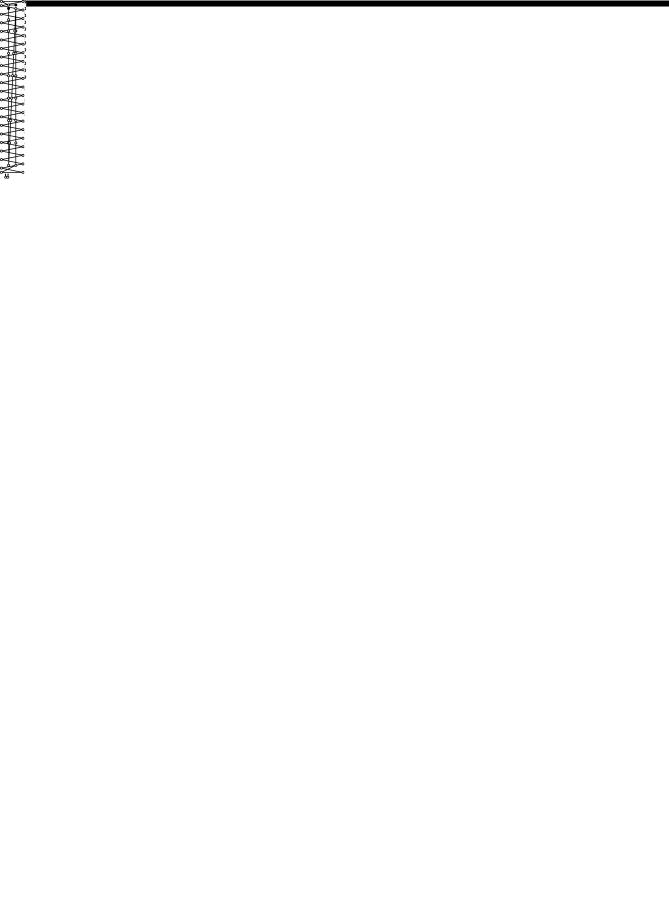
2. SPECIFICATIONS
|
Vertical bar tacking |
|
|
|
Vertical straight bar tacking |
|
|
|||
|
|
|
|
|
|
|
|
|
|
|
No. |
Sewing pattern |
No.of |
Tacking size (mm) |
No. |
Sewing pattern |
No.of |
|
Tacking size (mm) |
||
stitches |
Length |
Width |
stitches |
|
Length |
Width |
||||
|
|
|
|
|
||||||
26 |
|
28 |
3 |
10 |
28 |
|
19 |
|
0.3 |
10 |
|
|
|
|
|
|
|
|
|
|
|
27 |
|
35 |
3 |
10 |
29 |
|
21 |
|
0.3 |
10 |
|
|
|
|
|
|
|
|
|
|
|
40 |
|
32 |
3 |
16 |
30 |
|
28 |
|
0.3 |
10 |
|
|
|
|
|
|
|
|
|
|
|
41 |
|
36 |
3 |
16 |
46 |
|
27 |
|
0.3 |
20 |
|
|
|
|
|
|
|
|
|
|
|
42 |
|
44 |
3 |
20 |
47 |
|
44 |
|
0.3 |
25 |
|
|
|
|
|
|
|
|
|
|
|
43 |
|
68 |
3 |
24 |
|
|
|
|
|
|
|
|
|
|
|
|
|
|
|
|
|
5 |
KE-430D, BE-438D |

2. SPECIFICATIONS
Crescent bar tacking
No. |
Sewing pattern |
No.of |
|
Tacking size (mm) |
No. |
Sewing pattern |
|
No.of |
Tacking size (mm) |
|||||
stitches |
|
Length |
Width |
|
stitches |
Length |
Width |
|||||||
|
|
|
|
|
|
|
|
|||||||
|
|
|
|
|
|
|
|
|
|
|
|
|
|
|
34 |
|
|
|
35 |
12 |
7 |
|
37 |
|
|
57 |
7 |
12 |
|
|
|
|
|
|
|
|
|
|
|
|
|
|
|
|
35 |
|
|
|
58 |
12 |
7 |
|
38 |
|
|
53 |
7 |
10 |
|
|
|
|
|
|
|
|
|
|
|
|
|
|
|
|
36 |
|
|
|
57 |
7 |
12 |
|
39 |
|
|
53 |
7 |
10 |
|
|
|
|
|
|
|
|
|
|
|
|
|
|
|
|
|
|
|
|
|
|
|
|
|
|
|
|
|
|
|
|
Crossed stitching |
|
|
|
|
|
Crossed tacking |
|
|
|
||||
|
|
|
|
|
|
|
|
|
|
|
|
|
|
|
No. |
Sewing |
No.of |
|
Tacking size (mm) |
No. |
|
|
Sewing pattern |
|
No.of |
Tacking size (mm) |
|||
pattern |
stitches |
|
Length |
|
Width |
|
|
|
stitches |
Length |
Width |
|||
|
|
|
|
|
|
|
|
|||||||
|
|
|
|
|
|
|
|
|
|
|
|
|
|
|
48 |
|
70 |
|
10 |
|
10 |
50 |
|
|
|
|
84 |
16 |
16 |
|
|
|
|
|
|
|
|
|
|
|
|
|
|
|
49 |
|
93 |
|
9.6 |
|
9.6 |
51 |
|
|
|
|
105 |
30 |
26 |
|
|
|
|
|
|
|
|
|
|
|
|
|
|
|
KE-430D, BE-438D |
6 |

2. SPECIFICATIONS
L-pattern tacking
No. |
Sewing pattern |
No.of |
Tacking size (mm) |
No. |
|
Sewing pattern |
No.of |
Tacking size (mm) |
||
stitches |
Length |
Width |
|
stitches |
Length |
Width |
||||
|
|
|
|
|
||||||
|
|
|
|
|
|
|
|
|
|
|
52 |
|
60 |
11.3 |
11.2 |
53 |
|
|
60 |
11.3 |
11.2 |
|
|
|
|
|
|
|
|
|
|
|
54 |
|
78 |
15.3 |
15.2 |
55 |
|
|
78 |
15.3 |
15.2 |
|
|
|
|
|
|
|
|
|
|
|
|
|
|
|
Circular stitching |
|
|
|
|
||
|
|
|
|
|
|
|
|
|
||
No. |
Sewing pattern |
No.of |
Tacking size (mm) |
No. |
|
Sewing pattern |
No.of |
Tacking size (mm) |
||
stitches |
Length |
Width |
|
stitches |
Length |
Width |
||||
|
|
|
|
|
||||||
56 |
|
106 |
9 |
9 |
59 |
|
|
104 |
10 |
10 |
|
|
|
|
|
|
|
|
|
|
|
57 |
|
116 |
9 |
9 |
60 |
|
|
114 |
10 |
10 |
|
|
|
|
|
|
|
|
|
|
|
58 |
|
127 |
9 |
9 |
61 |
|
|
124 |
10 |
10 |
|
|
|
|
|
|
|
|
|
|
|
|
For eyelet buttonhole |
|
|
|
|
|
|
|
|
|
|
|
|
|
|
|
|
|
|
|
|
No. |
Sewing pattern |
No.of |
Tacking size (mm) |
|
|
|
|
|
|
|
stitches |
Length |
Width |
|
|
|
|
|
|
||
|
|
|
|
|
|
|
|
|||
|
|
|
|
|
|
|
|
|
|
|
86 |
|
21 |
6 |
2 |
|
|
|
|
|
|
|
|
|
|
|
|
|
|
|
|
|
87 |
|
28 |
6 |
2 |
|
|
|
|
|
|
|
|
|
|
|
|
|
|
|
|
|
88 |
|
35 |
6 |
2 |
|
|
|
|
|
|
|
|
|
|
|
|
|
|
|
|
|
If you want to sew a pattern other than standard patterns, you can create your original pattern using the PS-3000. Consult with your local Brother sales Office for details.
Note when creating additional data (program nos. 200 - 999)
When sewing data with a small number of stitches (15 stitches or less) is sewn repeatedly (short cycle operation), the upper shaft motor may overheat and the “E150” error code may be generated.
7 |
KE-430D, BE-438D |

2. SPECIFICATIONS
2-3. Program list (BE-438D)
The programs shown below have been preset into the sewing machine. Any program is available as long as the needle drops down in the hole of the button.
When sewing programs that do not have crossover stitches, the thread is trimmed after sewing of one side is completed, and then the other side is sewn.
|
No. |
|
No. of |
|
Sewing |
No. of |
No. of |
No. of |
Sewing size (mm) |
|
|
|
|
crossover |
|
|
|||||
|
|
button holes |
|
pattern |
threads |
stitches |
X |
Y |
||
|
|
|
|
stitches |
||||||
|
|
|
|
|
|
|
|
|
|
|
|
1 |
|
|
|
|
6 |
― |
12 |
|
|
|
|
|
|
|
|
|
|
|
|
|
|
2 |
|
|
|
|
8 |
― |
14 |
|
|
|
|
|
|
|
|
|
|
|
|
|
|
3 |
|
|
|
|
10 |
― |
16 |
|
|
|
|
|
|
|
|
|
|
|
3.4 |
0 |
|
4 |
|
|
|
|
12 |
― |
18 |
||
|
|
|
|
|
|
|
||||
|
|
|
|
|
|
|
|
|
|
|
|
5 |
*1 |
2 |
|
|
16 |
― |
22 |
|
|
|
|
|
|
|
|
|||||
|
|
|
|
|
|
|
|
|
|
|
|
|
|
|
|
|
|
|
|
|
|
|
6 |
*1 |
|
|
|
20 |
― |
26 |
|
|
|
|
|
|
|
|
|
||||
|
|
|
|
|
|
|
|
|
|
|
|
|
|
|
|
|
|
|
|
|
|
|
7 |
*2 |
|
|
|
6 |
― |
12 |
|
|
|
|
|
|
|
|
|
||||
|
|
|
|
|
|
|
|
|
|
|
|
|
|
|
|
|
|
|
|
|
|
|
23 |
*2 |
|
|
|
10 |
― |
16 |
0 |
3.4 |
|
|
|
|
|
||||||
|
|
|
|
|
|
|
|
|
|
|
|
|
|
|
|
|
|
|
|
|
|
|
8 |
*2 |
|
|
|
12 |
― |
18 |
|
|
|
|
|
|
|
|
|
||||
|
|
|
|
|
|
|
|
|
|
|
|
|
|
|
|
|
|
|
|
|
|
|
9 |
*2 |
|
|
|
5-5-5 |
― |
21 |
|
|
|
|
|
|
|
|
|
||||
|
|
|
|
|
|
|
|
|
|
|
|
|
|
|
|
|
|
|
|
|
|
|
24 |
*2 |
|
|
|
7-7-7 |
― |
27 |
|
|
|
|
|
|
|
|
|
||||
|
|
3 |
|
|
|
|
|
2.6 |
2.4 |
|
|
|
|
|
|
|
|
|
|||
|
25 |
*2 |
|
|
5-5-5 |
― |
21 |
|||
|
|
|
|
|
|
|||||
|
|
|
|
|
|
|
||||
|
|
|
|
|
|
|
|
|
|
|
|
|
|
|
|
|
|
|
|
|
|
|
26 |
*2 |
|
|
|
7-7-7 |
― |
27 |
|
|
|
|
|
|
|
|
|
||||
|
|
|
|
|
|
|
|
|
|
|
|
|
|
|
|
|
|
|
|
|
|
|
10 |
|
|
|
|
6-6 |
1 |
19 |
|
|
|
|
|
|
|
|
|
|
|
|
|
|
11 |
|
|
|
|
8-8 |
1 |
23 |
|
|
|
|
|
4 |
|
|
|
|
|
3.4 |
3.4 |
|
12 |
|
|
|
8-8 |
3 |
25 |
|||
|
|
|
|
|
|
|
|
|
|
|
|
13 |
|
|
|
|
10-10 |
1 |
27 |
|
|
|
|
|
|
|
|
|
|
|
|
|
|
27 |
|
|
|
|
12-12 |
1 |
31 |
|
|
|
|
|
|
|
|
|
|
|
||
*1 |
Check that the button hole diameter is 2 mm or greater before using the programs. |
|
|
|
||||||
*2 |
Do not use the button lifter spring. |
|
|
|
|
|
|
|||
KE-430D, BE-438D |
8 |

2. SPECIFICATIONS
No. |
|
No. of |
Sewing |
No. of |
No. of |
No. of |
Sewing size (mm) |
|
|
crossover |
|
|
|||||
|
button holes |
pattern |
threads |
stitches |
X |
Y |
||
|
|
stitches |
||||||
|
|
|
|
|
|
|
|
|
14 |
*3 |
|
|
6-6 |
0 |
24 |
|
|
|
|
|
|
|
||||
|
|
|
|
|
|
|
|
|
|
|
|
|
|
|
|
|
|
36 |
*4 |
|
|
6-6 |
0 |
24 |
|
|
|
|
|
|
|
||||
|
|
|
|
|
|
|
|
|
|
|
|
|
|
|
|
|
|
28 |
*3 |
|
|
8-8 |
0 |
28 |
|
|
|
|
|
|
|
||||
|
|
|
|
|
|
|
|
|
|
|
|
|
|
|
|
|
|
37 |
*4 |
|
|
8-8 |
0 |
28 |
|
|
|
|
|
|
|
||||
|
|
|
|
|
|
|
|
|
|
|
|
|
|
|
|
|
|
15 |
*3 |
|
|
10-10 |
0 |
32 |
|
|
|
|
|
|
|
||||
|
|
|
|
|
|
|
|
|
|
|
|
|
|
|
|
|
|
38 |
*4 |
|
|
10-10 |
0 |
32 |
|
|
|
|
|
|
|
||||
|
|
|
|
|
|
|
|
|
|
|
|
|
|
|
|
|
|
29 |
*3 |
|
|
12-12 |
0 |
36 |
|
|
|
|
|
|
|
||||
|
|
|
|
|
|
|
|
|
|
|
|
|
|
|
|
|
|
39 |
*4 |
|
|
12-12 |
0 |
36 |
|
|
|
|
|
|
|
||||
|
|
|
|
|
|
|
|
|
|
|
|
|
|
|
|
|
|
16 |
|
|
|
6-5 |
1 |
18 |
|
|
|
|
|
|
|
|
|
|
|
17 |
|
|
|
8-7 |
1 |
22 |
|
|
|
|
4 |
|
|
|
|
3.4 |
3.4 |
30 |
|
|
10-9 |
1 |
26 |
|||
|
|
|
|
|
|
|
|
|
18 |
|
|
|
6-6 |
1 |
19 |
|
|
|
|
|
|
|
|
|
|
|
19 |
|
|
|
8-8 |
1 |
23 |
|
|
|
|
|
|
|
|
|
|
|
31 |
|
|
|
10-10 |
1 |
27 |
|
|
|
|
|
|
|
|
|
|
|
45 |
|
|
|
12-12 |
1 |
31 |
|
|
|
|
|
|
|
|
|
|
|
20 |
*3 |
|
|
6-6 |
0 |
24 |
|
|
|
|
|
|
|
||||
|
|
|
|
|
|
|
|
|
|
|
|
|
|
|
|
|
|
40 |
*4 |
|
|
6-6 |
0 |
24 |
|
|
|
|
|
|
|
||||
|
|
|
|
|
|
|
|
|
|
|
|
|
|
|
|
|
|
32 |
*3 |
|
|
8-8 |
0 |
28 |
|
|
|
|
|
|
|
||||
|
|
|
|
|
|
|
|
|
|
|
|
|
|
|
|
|
|
41 |
*4 |
|
|
8-8 |
0 |
28 |
|
|
|
|
|
|
|
||||
|
|
|
|
|
|
|
|
|
|
|
|
|
|
|
|
|
|
33 |
*3 |
|
|
10-10 |
0 |
32 |
|
|
|
|
|
|
|
||||
|
|
|
|
|
|
|
|
|
|
|
|
|
|
|
|
|
|
42 |
*4 |
|
|
10-10 |
0 |
32 |
|
|
|
|
|
|
|
||||
|
|
|
|
|
|
|
|
|
|
|
|
|
|
|
|
|
|
*3 When sewing of one side is completed, the button clamp rises and the thread is trimmed. To finish sewing, press the foot switch until sewing of the other side starts, or press the foot switch again after sewing of the other side is completed.
*4 When sewing of one side is completed, the thread will be trimmed without the button clamp rising, and then the other side will be sewn.
9 |
KE-430D, BE-438D |

2. SPECIFICATIONS
|
No. |
|
No. of |
|
Sewing |
|
No. of |
|
|
No. of |
No. of |
Sewing size (mm) |
||||||
|
|
|
|
|
|
crossover |
|
|
||||||||||
|
|
button holes |
|
pattern |
|
threads |
|
|
stitches |
X |
Y |
|||||||
|
|
|
|
|
|
|
stitches |
|||||||||||
|
|
|
|
|
|
|
|
|
|
|
|
|
|
|
|
|
||
|
21 |
*2 |
|
|
|
|
|
|
6-6 |
|
1 |
|
19 |
|
|
|
||
|
|
|
|
|
|
|
|
|
|
|
|
|
||||||
|
|
|
|
|
|
|
|
|
|
|
|
|
|
|
|
|
|
|
|
|
|
|
|
|
|
|
|
|
|
|
|
|
|
|
|
|
|
|
34 |
*2 |
|
|
|
|
|
|
10-10 |
|
1 |
|
27 |
|
|
|
||
|
|
|
|
|
|
|
|
|
|
|
|
|
||||||
|
|
|
|
|
|
|
|
|
|
|
|
|
|
|
|
|
|
|
|
|
|
|
|
|
|
|
|
|
|
|
|
|
|
|
|
|
|
|
22 |
*2 *3 |
|
|
|
|
|
|
6-6 |
|
0 |
|
24 |
|
|
|
||
|
|
|
|
|
|
|
|
|
|
|
|
|
||||||
|
|
|
|
|
|
|
|
|
|
|
|
|
|
|
|
2.4 |
3.4 |
|
|
|
|
|
|
|
|
|
|
|
|
|
|
|
|
|
|
||
|
43 |
*2 *4 |
|
|
|
|
|
|
6-6 |
|
0 |
|
24 |
|
||||
|
|
|
|
|
|
|
|
|
|
|
|
|||||||
|
|
|
|
|
|
|
|
|
|
|
|
|
||||||
|
|
|
|
|
|
|
|
|
|
|
|
|
|
|
|
|
|
|
|
|
|
|
|
|
|
|
|
|
|
|
|
|
|
|
|
|
|
|
35 |
*2 *3 |
|
|
|
|
|
|
10-10 |
|
0 |
|
32 |
|
|
|
||
|
|
|
|
|
|
|
|
|
|
|
|
|
||||||
|
|
4 |
|
|
|
|
|
|
|
|
|
|
|
|
|
|
|
|
|
|
|
|
|
|
|
|
|
|
|
|
|
|
|
|
|
|
|
|
44 |
*2 *4 |
|
|
|
|
|
10-10 |
|
0 |
|
32 |
|
|
|
|||
|
|
|
|
|
|
|
|
|
|
|
|
|||||||
|
|
|
|
|
|
|
|
|
|
|
|
|
||||||
|
|
|
|
|
|
|
|
|
|
|
|
|
|
|
|
|
|
|
|
|
|
|
|
|
|
|
|
|
|
|
|
|
|
|
|
|
|
|
46 |
|
|
|
|
|
|
|
6-6 |
|
1 |
|
19 |
|
|
|
||
|
|
|
|
|
|
|
|
|
|
|
|
|
|
|
|
|
|
|
|
47 |
|
|
|
|
|
|
|
8-8 |
|
1 |
|
23 |
|
|
|
||
|
|
|
|
|
|
|
|
|
|
|
|
|
|
|
|
|
3.4 |
3.4 |
|
48 |
|
|
|
|
|
|
|
10-10 |
|
1 |
|
27 |
|
||||
|
|
|
|
|
|
|
|
|
|
|
|
|
||||||
|
|
|
|
|
|
|
|
|
|
|
|
|
|
|
|
|
|
|
|
49 |
|
|
|
|
|
|
|
12-12 |
|
1 |
|
31 |
|
|
|
||
|
|
|
|
|
|
|
|
|
|
|
|
|
|
|
|
|
|
|
*2 |
Do not use the button lifter spring. |
|
|
|
|
|
|
|
|
|
|
|
|
|
|
|||
*3 |
When sewing of one side is completed, the button clamp rises and the thread is trimmed. To finish sewing, press the foot |
|||||||||||||||||
|
switch until sewing of the other side starts, or press the foot switch again after sewing of the other side is completed. |
|||||||||||||||||
*4 |
When sewing of one side is completed, the thread will be trimmed without the button clamp rising, and then the other |
|||||||||||||||||
|
side will be sewn. |
|
|
|
|
|
|
|
|
|
|
|
|
|
|
|||
|
|
|
|
|
|
|
|
|
|
|
|
|
|
|
|
|
||
|
|
|
|
|
For shank button |
|
|
|
|
|
|
|
|
|
|
|||
|
|
|
|
|
|
|
|
|
|
|
|
Sewing size (mm) |
|
|
|
|||
|
No. |
|
Sewing pattern |
|
No. of threads |
|
No. of |
|
|
|
|
|||||||
|
|
|
|
stitches |
|
X |
|
Y |
|
|
|
|||||||
|
|
|
|
|
|
|
|
|
|
|
|
|
|
|
||||
|
50 |
|
|
|
|
|
6 |
|
|
|
12 |
|
|
|
|
|
|
|
|
|
|
|
|
|
|
|
|
|
|
|
|
|
|
|
|
|
|
|
51 |
|
|
|
|
|
8 |
|
|
|
14 |
|
|
|
|
|
|
|
|
|
|
|
|
|
|
|
|
|
|
|
|
3.4 |
|
0 |
|
|
|
|
52 |
|
|
|
|
|
10 |
|
|
|
16 |
|
|
|
|
|
||
|
|
|
|
|
|
|
|
|
|
|
|
|
|
|
|
|||
|
|
|
|
|
|
|
|
|
|
|
|
|
|
|
|
|
|
|
|
53 |
|
|
|
|
|
12 |
|
|
|
18 |
|
|
|
|
|
|
|
|
|
|
|
|
|
|
|
|
|
|
|
|
|
|
|
|
|
|
Note when creating additional data (program nos. 200 - 999)
When sewing data with a small number of stitches (15 stitches or less) is sewn repeatedly (short cycle operation), the upper shaft motor may overheat and the “E150” error code may be generated.
KE-430D, BE-438D |
10 |
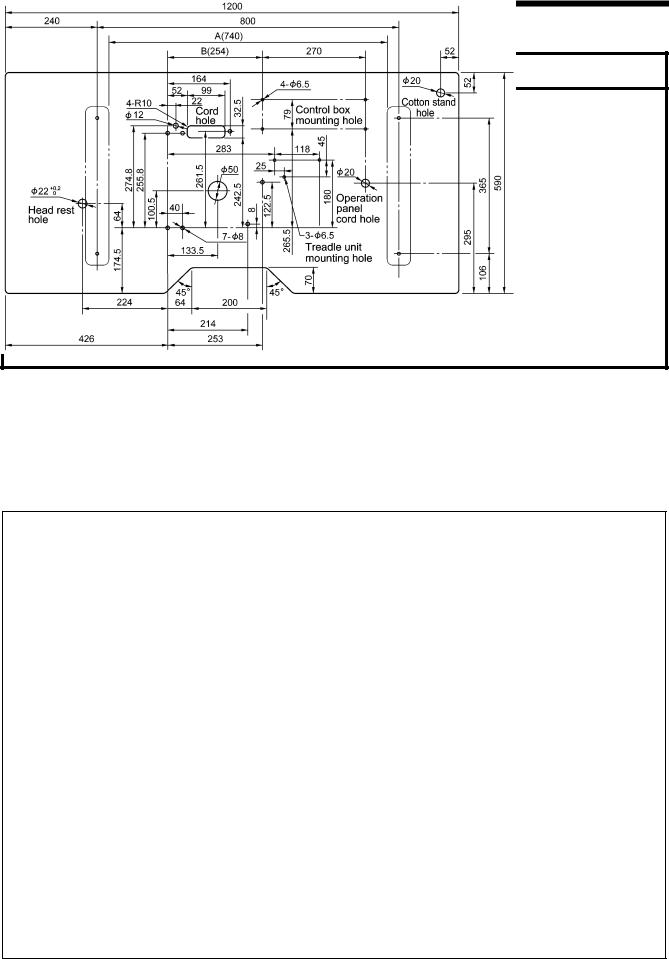
3. INSTALLATION
3. INSTALLATION
Machine installation should only be carried out by a |
All cords should be secured at least 25 mm away |
||||||
qualified technician. |
from any moving parts. Furthermore, do not |
||||||
Contact your Brother dealer or a qualified electrician |
excessively bend |
the cable |
or |
secure |
it too |
firmly |
|
staples, otherwise |
there is |
the |
danger |
that |
fire or |
||
for any electrical work that may need to be done. |
|||||||
electric shocks could occur. |
|
|
|
|
|||
The sewing machine head weighs approximately 56 |
|
|
|
|
|||
Be sure to connect the |
ground. If |
the ground |
|||||
kg. The installation should be carried out by two or |
|||||||
connection is not secure, you run the risk of receiving |
|||||||
more people. |
|||||||
a serious electric shock, and problems with correct |
|||||||
Do not connect the power cord until installation is |
|||||||
operation may also occur. |
|
|
|
|
|||
complete, otherwise the machine may operate if the |
Install the safety covers to |
the |
machine head and |
||||
foot switch is depressed by mistake, which could |
|
|
|
|
|
|
|
CAUTION |
|
|
|
|
|
||
result in injury. |
motor. |
|
|
Hold the machine head with both hands when tilting it |
|
back or returning it to its original position. |
|
Furthermore, after tilting back the machine head, do |
|
not push the face plate side or the pulley side from |
|
above, as this could cause the machine head to |
|
topple over, which may result in personal injury or |
|
damage to the machine. |
|
3-1. Table processing diagram
•The thickness of the table should be at least 40 mm, and it should be strong enough to bear the weight and vibration of the sewing machine.
•If the distance A between the insides of the legs is less than 740 mm, move the control box installation position to the left (B = 254 mm).
•Check that the control box is at least 10 mm away from the leg. If the control box and the leg are too close together, it may result in incorrect sewing machine operation.
3625M
11 |
KE-430D, BE-438D |
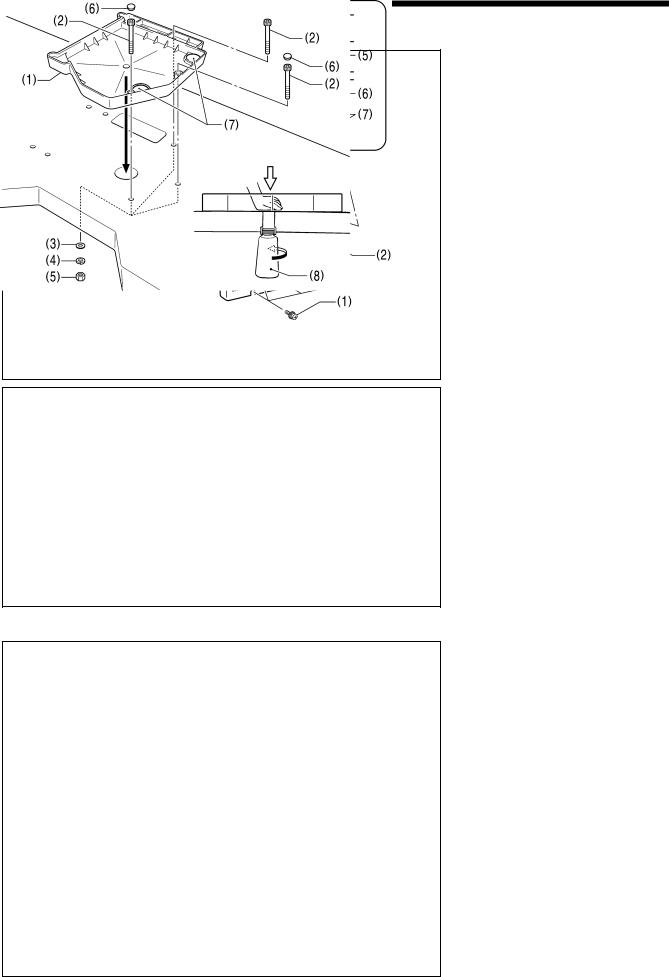
3. INSTALLATION
3-2. Installing the control box
4403Q
Remove the eight screws (1), and then remove the control box cover (2).
(3)Control box
(4)Bolts [4 pcs]
(5)Spacers [4 pcs]
(6)Plain washers [4 pcs]
(7)Nuts [8 pcs]
*The recommended tightening torque for the nuts (7) is 4.0±0.1N m.
(8) Power switch
(9) Wood screws [2 pcs]
(10) Staples [4 pcs]
Operator
4404Q
3-3. Installing the oil pan
(1) |
Oil pan |
|
|
(2) |
Bolts [3 pcs] |
|
(3) |
Plain washers [3 pcs] |
|
(4) |
Spring washers [3 pcs] |
|
(5) |
Nuts [3 pcs] |
|
(6) |
Rubber caps [2 pcs] |
|
(7) |
Rubber cushion [2 pcs] |
|
(8) |
Oiler |
|
|
|
4405Q
KE-430D, BE-438D |
12 |
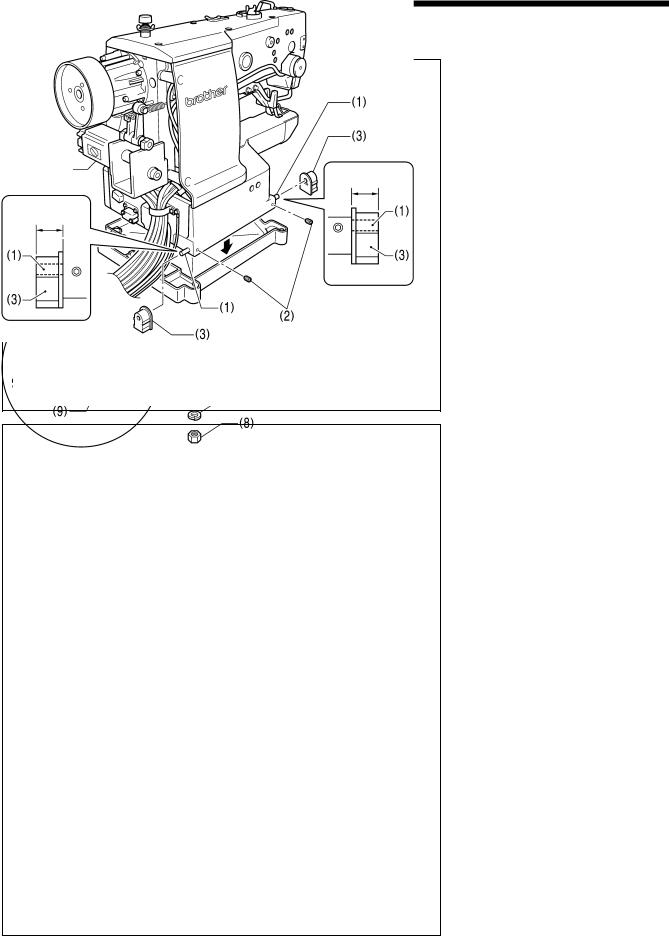
3. INSTALLATION
3-4. Installing the machine head
Pulse motor |
Approx. 20mm |
|
|
Approx. 20mm |
|
4406Q
(1)Pins [2 pcs]
(2)Set screws [2 pcs]
(3)Rubber cushion assembly [2 pcs]
Place the machine head gently on top of the oil pan and the rubber cushions.
Note:
•Be careful not to clamp any cords between the machine head and the oil pan.
•When holding the machine head, do not hold it by the pulse motor, otherwise it may damage the pulse motor.
(4) Hinge holders [2 pcs]
(5) Bolts [4 pcs]
(6) Plain washers [4 pcs]
(7) Spring washers [4 pcs]
(8) Nuts [4 pcs]
(9) Head spring (10)Head rest
Note:
• Check that the machine head switch is turned on as shown in Figure 1.
• Tap the head rest (10) securely into the table hole.
Figure
4407Q
13 |
KE-430D, BE-438D |
